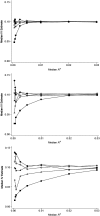Efficient design for Mendelian randomization studies: subsample and 2-sample instrumental variable estimators
- PMID: 23863760
- PMCID: PMC3783091
- DOI: 10.1093/aje/kwt084
Efficient design for Mendelian randomization studies: subsample and 2-sample instrumental variable estimators
Abstract
Mendelian randomization (MR) is a method for estimating the causal relationship between an exposure and an outcome using a genetic factor as an instrumental variable (IV) for the exposure. In the traditional MR setting, data on the IV, exposure, and outcome are available for all participants. However, obtaining complete exposure data may be difficult in some settings, due to high measurement costs or lack of appropriate biospecimens. We used simulated data sets to assess statistical power and bias for MR when exposure data are available for a subset (or an independent set) of participants. We show that obtaining exposure data for a subset of participants is a cost-efficient strategy, often having negligible effects on power in comparison with a traditional complete-data analysis. The size of the subset needed to achieve maximum power depends on IV strength, and maximum power is approximately equal to the power of traditional IV estimators. Weak IVs are shown to lead to bias towards the null when the subsample is small and towards the confounded association when the subset is relatively large. Various approaches for confidence interval calculation are considered. These results have important implications for reducing the costs and increasing the feasibility of MR studies.
Keywords: Mendelian randomization; epidemiologic methods; instrumental variable.
Figures




References
-
- Lawlor DA, Harbord RM, Sterne JA, et al. Mendelian randomization: using genes as instruments for making causal inferences in epidemiology. Stat Med. 2008;27(8):1133–1163. - PubMed
-
- Didelez V, Sheehan N. Mendelian randomization as an instrumental variable approach to causal inference. Stat Methods Med Res. 2007;16(4):309–330. - PubMed
-
- Angrist JD, Krueger AB. The effect of age at school entry on educational attainment: an application of instrumental variables with moments from two samples. J Am Stat Assoc. 1992;87(418):328–336.
-
- Inoue A, Solon G. Two-sample instrumental variables estimators. Rev Econ Stat. 2010;92(3):557–561.
Publication types
MeSH terms
Grants and funding
LinkOut - more resources
Full Text Sources
Other Literature Sources

